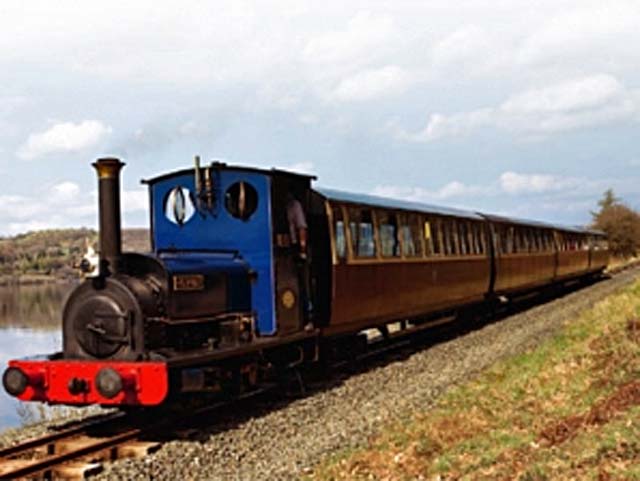
| 

Holy War heads back to Llanuwchyllun along the western shores of Lake Bala, or Llyn Tegid - Date/Photographer unknown.
6 August 2012 Four Decades of Bala Steam There were many who loudly lamented the closure of the fabulously scenic Great Western Railway (GWR) Ruabon to Dolgellau route in 1965 under the Beeching Axe. Two heritage railways now occupy part of the track bed, the standard gauge Llangollen Railway and the 2 foot (1 foot 11 1/2 inches) gauge Bala Lake Railway, which is now celebrating its 40th anniversary and is being developed as a major operational centre for Snowdonia slate quarry steam heritage when visitors can drive a Quarry Hunslet for themselves, writes Robin Jones.
Back in 1971, when there was no Welsh Highland, Corris, or Brecon Mountain railways, and the Ffestiniog, Welshpool & Llanfair, and Talyllyn were still extending their operational lines towards their eventual goals, the birth of the Bala Lake Railway was a godsend.
The route of the Bala & Dolgelley Railway, part of the GWR cross-country line from Ruabon to Dolgellau closed to passenger services on 15 Jan 1865, was just too good to let it slip by.
In fact, as exclusively revealed in my new special publication, "Beeching: Inside and Out", marking the 50th anniversary of the publication of the watershed report "The Reshaping of British Railways" in March 1963, its closure was not as clear cut as it might seem. There were those inside Dr. Beeching's planning department who thought at the time that the Minister of Transport might well decide to save it on social grounds.
History records, however, that freight over the route ended in 1964, apart from the Llangollen to Ruabon section which remained open until 1968. Lifting of the track was completed in 1969.
When in 1971 local engineer George Barnes, inspired by the revival of other Welsh narrow gauge lines, saw the potential of the lakeside section for both local and tourist traffic, with a 2 foot gauge line being laid on the old formation, it came as a godsend.
With the help of the late Tom Jones CBE, then chairman of Merioneth County Council's finance committee, a railway enthusiast and a Llanuwchllyn resident, Rheilffordd Llyn Tegid Cyf (Bala Lake Railway Ltd.) became the first company to be registered in the Welsh language.
It also had the honour of becoming the first narrow gauge railway to be built on a former British Railways standard gauge track bed.
Tracklaying began early in 1972 and the first section from Llanuwchllyn, where the main railway buildings, workshops, and offices are located, was opened to the public on 13 Aug 1972. Llangower was reached in September 1972, Pant-yr-hen-felin in time for the 1975 season, and Bala (Llyn Tegid) in 1976.
Llanuwchllyn's GWR buildings survive, the buffet being the former waiting room. The main building has been extended on the site of the old toilets to provide a booking office and store room. The waiting room on platform two is now an office.
The seating section was once a waiting room at Morfa Mawddach (Barmouth Junction) while the canopy supports were built for the Cambrian Railways station at Pwllheli, but were taken down when the station was moved in 1907. They were then used at Aberdovey until 1979 when they were moved to Llanuwchllyn.
The cattle dock is now the picnic area and the stone goods is used as a woodwork shop.
Llangower is the main intermediate station on the line, and lies very close to the shore of the lake. Just past the platform, there is a passing loop which is brought into use at very busy periods.
Bala is the northern terminus of the line and lies about half a mile from the centre of the town, on the site of a station of 1868 which closed in 1886.
From the outset there have been various plans to extend the railway into Bala itself, possibly along the route of the old Bala & Ffestiniog line, and the idea is being considered again. If this happened, it would give the railway a major presence alongside the holiday traffic route through the town and would be guaranteed to benefit local businesses as more visitors would turn off to look at it, increasing visitor spend.
With the successful operation of the Welsh Highland & Ffestiniog system, which offers a 40-mile steam highway through Snowdonia, the Bala Lake Railway may seem like small beer by today's standards, and is often overlooked by enthusiasts who think disparagingly of narrow gauge tourist lines on former standard gauge track beds.
Yet the Bala Lake comes into its own with its ability to showcase locomotives from the Welsh slate mines which are too small to work passenger services on the bigger lines, yet have a thorough Snowdonia slate industry pedigree, having worked for generations out of sight of the general public on the various levels of Dinorwic Quarry. The lakeside landscape has evolved over the years, and while the railway is kept in immaculate condition, the growth of trees and bushes hides the fact that at one time a full-size railway ran there.
The current motive power comprises three Quarry Hunslets, Holy War, Alice, and Maid Marian.
No. 779 of 1902, Holy War, was named after a racehorse in 1908. While working in the great quarry, it became trapped by a rock fall and had to be dismantled and taken down to a lower level by a temporary rope way piece by piece. Nevertheless, Holy War was the last operational engine at the quarries, working until November 1967.
Holy War was eventually bought by the Reverend Alan Cliff, creator of the "Jack the Station Cat" series of books, who brought it to the Bala Lake Railway for a major overhaul in December 1975. It returned to full service on Good Friday 1979, and was sold to the railway company a decade later.
No. 780 of 1902, Alice, is the sister engine to Holy War. It last worked in Dinorwic in 1960 before becoming a donor of spare parts to keep other engines working. It was bought for preservation only with this in mind, however, a full restoration programme was started at Bala in the late Seventies. It was completed at the Leighton Buzzard Railway after moving there in 1990 and worked there until 2003 when it returned. It is now owned by preservation powerhouse Julian Birley, the man who drove the project to reconnect the North Norfolk Railway to the national network, and who, as recently highlighted in Heritage Railway, has reassembled a genuine rake of loose-coupled Dinorwic Quarry wagons to run behind it.
No. 822 of 1903, Maid Marian, also named after a racehorse, was withdrawn from quarry service in 1964 and acquired by the Maid Marian Locomotive Fund on 6 May 1967. At first it went to Bressingham Steam Museum, only to return to Llanberis in 1971, working on the then-new Llanberis Lake Railway, before finally arriving at Bala in 1975 and entering service at Easter.
A fourth Dinorwic Quarry Hunslet at the railway is privately owned 1898-built No. 680, George B. It was bought direct from the quarry in 1965 and dismantled in 1969 for a full overhaul which is still under way in the workshops at Llanuwchllyn.
They have now been joined by a fifth Quarry Hunslet, No. 364 of 1885, Winifred, which Julian repatriated from Indianapolis in May. Exported in 1965, but never steamed in the USA, it is still in very much the condition in which it left Penrhyn Quarry. Its overhaul is expected to take around 18 months with a possible return to service on the line in 2014.
The Bala Lake Railway is to hold a special 40th anniversary weekend on 11-12 Aug 2012.
The three operational Quarry Hunslets will be in steam, and they will take turns on the service train. Between trains, Julian's rake of slate wagons will be shunted around the Llanuwchllyn loop to show the work they were designed for.
If the weather is good enough, Winifred will be hauled outside so all four engines can be posed by the Llanuwchllyn workshop briefly between trains.
At Llanuwchllyn, visitors will be able to ride in the Dinorwic Yellow Truck, one of three built to convey Queen Victoria and her party through the great quarry, and which is on loan from the National Trust. What better way to celebrate diamond jubilee year than to ride in Britain's most unusual royal train!
From September, the railway is to introduce out-of-season driver experience courses, allowing visitors to take control of a Quarry Hunslet and a genuine Dinorwic slate train for two complete round trips of the 4 1/2 mile line.
Further details are available from the railway on 01678 54066.
Author unknown.



Vancouver Island
British Columbia
Canada |


